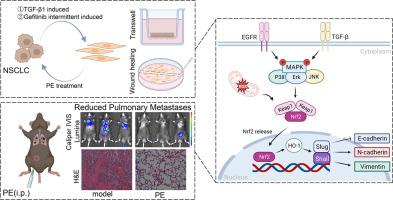Phytomedicine ( IF 7.9 ) Pub Date : 2023-05-16 , DOI: 10.1016/j.phymed.2023.154884 Qiumei Fan 1 , Xiaowei Liang 1 , Zhipeng Xu 1 , Siyuan Li 1 , Shan Han 1 , Yuntian Xiao 1 , Qiongming Xu 2 , Renyikun Yuan 1 , Shilin Yang 1 , Hongwei Gao 1

|
Background
Lung cancer is the primary cause of cancer-related mortality worldwide owing to its strong metastatic ability. EGFR-TKI (Gefitinib) has demonstrated efficacy in metastatic lung cancer therapy, but most patients ultimately develop resistance to Gefitinib, leading to a poor prognosis. Pedunculoside (PE), a triterpene saponin extracted from Ilex rotunda Thunb., has shown anti-inflammatory, lipid-lowering and anti-tumor effects. Nevertheless, the therapeutic effect and potential mechanisms of PE on NSCLC treatment are unclear.
Purpose
To investigate the inhibitory effect and prospective mechanisms of PE on NSCLC metastases and Gefitinib-resistant NSCLC.
Methods
In vitro, A549/GR cells were established by Gefitinib persistent induction of A549 cells with a low dose and shock with a high dose. The cell migratory ability was measured using wound healing and Transwell assays. Additionally, EMT-related Markers or ROS production were assessed by RT-qPCR, immunofluorescence, Western blotting, and flow cytometry assays in A549/GR and TGF-β1-induced A549 cells. In vivo, B16-F10 cells were intravenously injected into mice, and the effect of PE on tumor metastases were determined using hematoxylin-eosin staining, Caliper IVIS Lumina, DCFH2-DA staining, and western blotting assays.
Results
PE reversed TGF-β1-induced EMT by downregulating EMT-related protein expression through MAPK and Nrf2 pathways, decreasing ROS production, and inhibiting cell migration and invasion ability. Moreover, PE treatment enabled A549/GR cells to retrieve the sensitivity to Gefitinib and mitigate the biological characteristics of EMT. PE also significantly inhibited lung metastasis in mice by reversing EMT proteins expression, decreasing ROS production, and inhibiting MAPK and Nrf2 pathways.
Conclusions
Collectively, this research presents a novel finding that PE can reverse NSCLC metastasis and improve Gefitinib sensitivity in Gefitinib-resistant NSCLC through the MAPK and Nrf2 pathways, subsequently suppressing lung metastasis in B16-F10 lung metastatic mice model. Our findings indicate that PE is a potential agent for inhibiting metastasis and improving Gefitinib resistance in NSCLC.
中文翻译:

Pedunculoside 通过调节 MAPK 和 Nrf2 通路抑制上皮-间质转化并克服吉非替尼耐药的非小细胞肺癌
背景
由于其强大的转移能力,肺癌是全世界癌症相关死亡的主要原因。EGFR-TKI(吉非替尼)已证明在转移性肺癌治疗中有效,但大多数患者最终对吉非替尼产生耐药性,导致预后不良。Pedunculoside (PE) 是一种从冬青中提取的三萜皂苷,具有抗炎、降脂和抗肿瘤作用。然而,PE对NSCLC治疗的治疗效果和潜在机制尚不清楚。
目的
探讨PE对NSCLC转移和吉非替尼耐药NSCLC的抑制作用及前瞻性机制。
方法
在体外,吉非替尼低剂量持续诱导A549细胞,高剂量休克建立A549/GR细胞。使用伤口愈合和 Transwell 测定法测量细胞迁移能力。此外,在 A549/GR 和 TGF-β1 诱导的 A549 细胞中,通过 RT-qPCR、免疫荧光、蛋白质印迹和流式细胞术分析评估了 EMT 相关标记物或 ROS 的产生。在体内,将 B16-F10 细胞静脉注射到小鼠体内,并使用苏木精-伊红染色、Caliper IVIS Lumina、DCFH 2 -DA 染色和蛋白质印迹法测定 PE 对肿瘤转移的影响。
结果
PE 通过 MAPK 和 Nrf2 途径下调 EMT 相关蛋白表达,减少 ROS 产生,抑制细胞迁移和侵袭能力,从而逆转 TGF-β1 诱导的 EMT。此外,PE 处理使 A549/GR 细胞能够恢复对吉非替尼的敏感性并减轻 EMT 的生物学特性。PE 还通过逆转 EMT 蛋白表达、减少 ROS 产生以及抑制 MAPK 和 Nrf2 通路显着抑制小鼠肺转移。
结论
总的来说,这项研究提出了一个新发现,即 PE 可以通过 MAPK 和 Nrf2 通路逆转 NSCLC 转移并提高吉非替尼耐药 NSCLC 对吉非替尼的敏感性,从而抑制 B16-F10 肺转移小鼠模型中的肺转移。我们的研究结果表明,PE 是抑制 NSCLC 转移和改善吉非替尼耐药性的潜在药物。



























 京公网安备 11010802027423号
京公网安备 11010802027423号